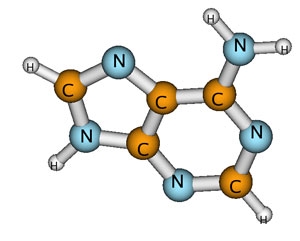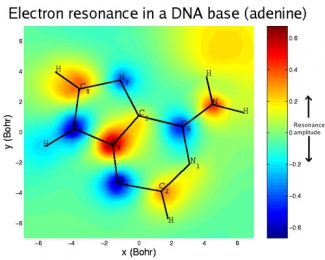High-energy radiation is notorious for damaging DNA, primarily by breaking chemical bonds. Damage to DNA can cause mutations, cancer, or even death. Much of this damage is inflicted by secondary, or low-energy, electrons knocked out of atoms in the DNA molecules by radiation. The low-energy electrons get captured by the DNA bases (which make up the letters of the genetic code), temporarily forming a negatively charged molecule (anion). The anion lasts just long enough to transfer its excess energy to the weakest nearby chemical bond, often breaking it.
In DNA, the weakest link is the carbon-oxygen bond between the sugar and phosphate groups that form its backbone. Low-energy electrons can cause breaks in one or both strands of DNA. Although the letters of the code remain undamaged, these structural breaks increase the likelihood that the code will be misread and permanent, and potentially catastrophic, biological changes will ensue.




 The Physics Frontiers Centers (PFC) program supports university-based centers and institutes where the collective efforts of a larger group of individuals can enable transformational advances in the most promising research areas. The program is designed to foster major breakthroughs at the intellectual frontiers of physics by providing needed resources such as combinations of talents, skills, disciplines, and/or specialized infrastructure, not usually available to individual investigators or small groups, in an environment in which the collective efforts of the larger group can be shown to be seminal to promoting significant progress in the science and the education of students. PFCs also include creative, substantive activities aimed at enhancing education, broadening participation of traditionally underrepresented groups, and outreach to the scientific community and general public.
The Physics Frontiers Centers (PFC) program supports university-based centers and institutes where the collective efforts of a larger group of individuals can enable transformational advances in the most promising research areas. The program is designed to foster major breakthroughs at the intellectual frontiers of physics by providing needed resources such as combinations of talents, skills, disciplines, and/or specialized infrastructure, not usually available to individual investigators or small groups, in an environment in which the collective efforts of the larger group can be shown to be seminal to promoting significant progress in the science and the education of students. PFCs also include creative, substantive activities aimed at enhancing education, broadening participation of traditionally underrepresented groups, and outreach to the scientific community and general public.